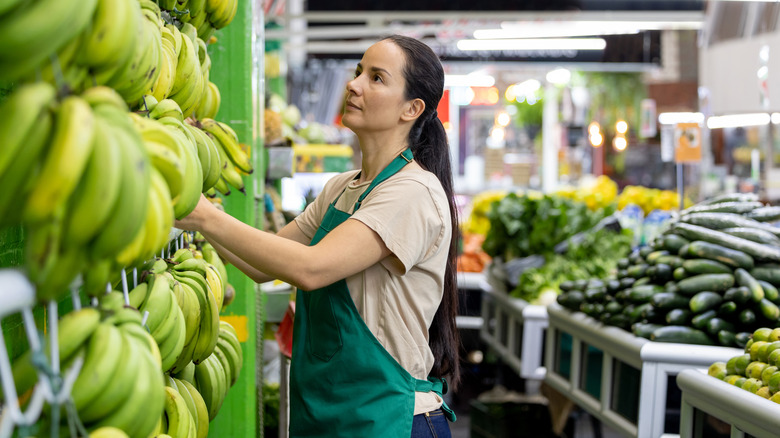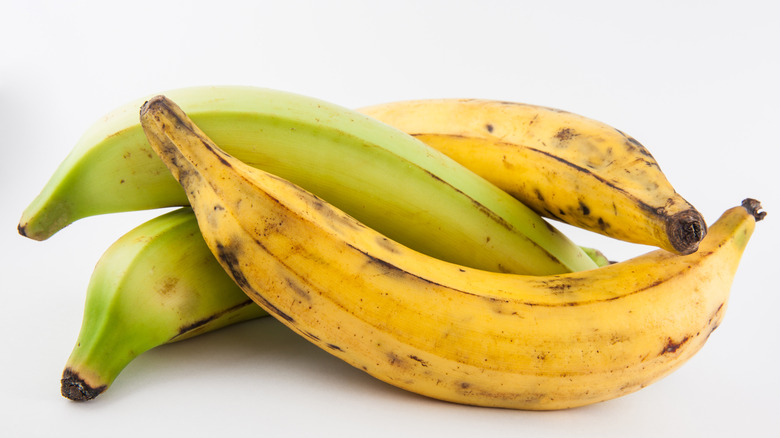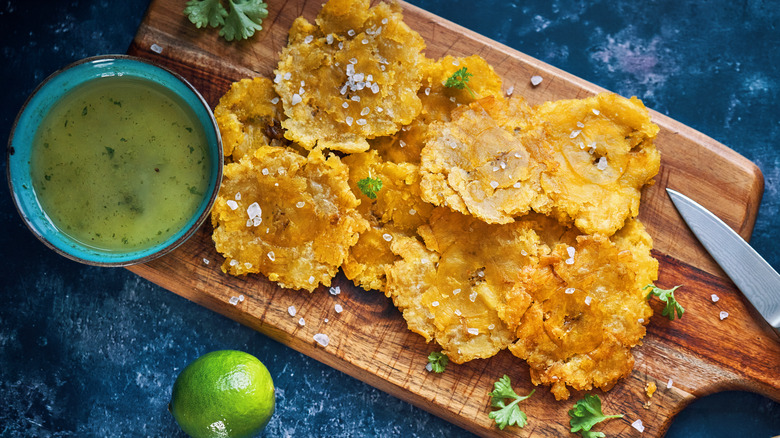Which Is Better For You: Plantains Or Bananas? What To Consider
Exploring the produce department at a grocery store offers the chance to discover a variety of fruits and vegetables to fulfill your daily five-a-day health goal. While some stores offer locally grown produce, others import tasty finds from all over the world. Although the plantain comes from Southeast Asia, it's a well-known ingredient in Caribbean, African, and South American cuisines.
You might have already come across plantains, thinking they were strange-looking bananas. That's because plantains are part of the banana family. What you typically slice over your breakfast cereal or toss into your workout bag is a Cavendish banana (via WebMD). Because these bananas are sweet, they're also known as dessert bananas and are eaten raw. Plantains, on the other hand, are probably not the best option for a pre-workout snack because they are more starchy and eaten cooked. Because plantains and Cavendish bananas come from the same family, they are relatively similar in nutrition. The main difference is how you prepare each fruit (via Healthline).
Comparing bananas and plantains
Green bananas and plantains are high in resistant starch, which promotes a healthy balance of gut bacteria. They are also high in fiber, so they keep your bowels in working order. As both fruits ripen, the starch begins to turn to sugar (via WebMD). While a 100-gram serving of green plantain has 152 calories, 37 grams of carbs, and 2 grams of sugar, a 100-gram yellow plantain has 122 calories, 32 grams of carbs, and 18 grams of sugar. Meanwhile, 100 grams of a slightly ripe banana will have 98 calories, 23 grams of carbohydrates, and 16 grams of sugar.
A banana is known for its potassium, and it offers 326 milligrams of this nutrient that helps your body maintain its fluid balance and regulates your heartbeat. Plantains have slightly more potassium with 487 milligrams and 50% more vitamin C.
Plantains and bananas have relatively low glycemic indices, which means they are good for people with diabetes because they don't spike your blood sugar. The low GI threshold is below 55, and plantains have a GI of 40 (via WebMD). The glycemic index of bananas depends on their ripeness. While they can range from a low GI of 47 to 53, an extremely ripe banana can peak at 57, which is a medium GI (via Glycemic Index).
Preparing bananas and plantains can be unhealthy
Less ripe plantains have the firmness of a potato, so many times they're boiled and mashed just like potatoes. Plantains are often part of savory dishes and added to stews. Yellow plantains are a little sweeter, and they get sweeter the more they are cooked. You can make healthy plantains by baking them in the oven. However, many recipes call for frying plantains, so the oil they absorb can make plantains unhealthy. Plantains can also make great desserts, but many of them include added sugar. Plantain chips are heavily processed and will often have excessive salt (via WebMD).
Unlike plantains, which are typically cooked, bananas are enjoyed in their raw form. You can still boil and mash green bananas like plantains, but the ripe ones can make a healthy addition to your breakfast cereals, pancakes, and smoothies. Bananas also make a nice substitute for oil or butter in some of your favorite recipes for baked goods. Like plantain chips, banana chips might sound like a healthy option, but they, too, are processed and often have salt, fat, and sugar (via Healthline).



